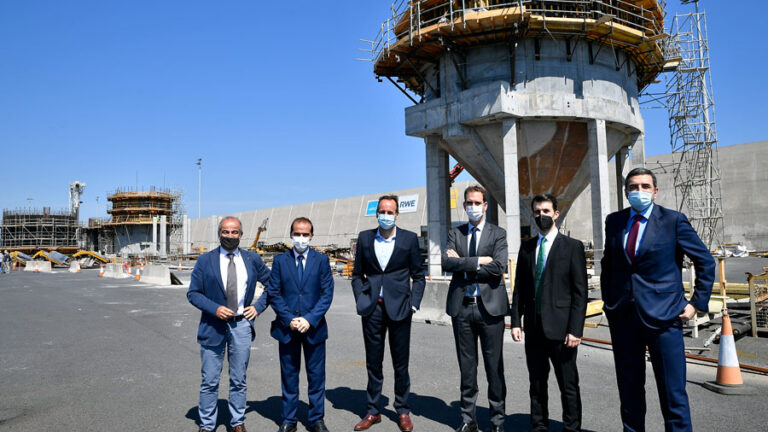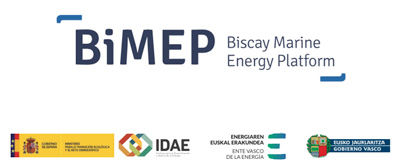El viceconsejero de Industria visita las obras que se desarrollan en el Puerto de Bilbao
- DemoSATH is a pioneering concrete platform developed by SAITEC engineering which has the potential to revolutionize the roll-out of floating offshore wind systems.
- Work is expected to be completed in spring 2022 with installation at BiMEP in summer that year.
- The technology has been developed entirely in the Basque Country. This will be the first grid-connected floating wind turbine in Spain.
The Basque deputy-minister for industry, Javier Zarraonandia, visited the site at Bilbao port where the large floating platform is being built, accompanied by the director-general of the Basque Energy Agency, Iñigo Ansola, and the CEO of the Saitec Group, Javier Urgoiti. The deputy minister highlighted the importance of R&D to the Basque energy industry, providing as it does “innovative technical solutions for improving our renewable energy supply and, at the same time, helping to develop a competitive industrial sector capable of exporting anywhere in the world”. Javier Urgoiti said that “the DemoSATH project demonstrates the potential of floating offshore wind power for local industry, as more than 70% of the contracts will be awarded within the province of Bizkaia”.
The new device —known as DemoSATH—was presented last summer in Armintza. The technology has been entirely developed by the Basque engineering firm SAITEC. The energy company RWE is also participating in the project and the device is being manufactured by Ferrovial at the port facilities. Construction is due to be completed in spring 2022. After launching, the floating wind turbine will be towed to its anchorage at the BiMEP site in Armintza.
The purpose is to test the device’s performance, capacity and endurance over a two-year period under real sea conditions at BiMEP’s test facilities. This is the first time a floating wind device will be tested in real operating conditions in Spain, and it is hoped that the result may open the way to use of this technology in new deep-water wind farms.
Basque technology for offshore wind
The technology behind the DemoSATH has been entirely developed by Saitec Offshore Technologies, a spin-off of engineering firm SAITEC, based in Leioa (Bizkaia). The large full-scale prototype consists of a floating concrete foundation 30 meters wide and 67 meters long, onto which a 2 MW wind turbine will be fitted, with the axis standing 70 meters above the surface.
There are numerous advantages to using concrete for floating offshore devices as compared to other materials, including its competitive cost, local job creation, lower maintenance, reduced carbon footprint and a lower price fluctuation than, for example, steel.
Like most of the world’s seas and oceans, the Cantabrian Sea at the south of the Bay of Biscay has almost no continental shelf, meaning that it drops to significant depths within just a few metres from the coast.
This hinders the installation of fixed-base offshore wind farms —such as those widely used in northern Europe— and so the development of floating technologies is essential for advancing new power generation that will contribute to the effective decarbonisation of global energy supply. It is a challenge that is being addressed by many technology companies around the world and the developments here place Basque R&D at the forefront in this field.
Saitec Offshore
Saitec Offshore Technologies is a spin-off of Saitec S.A. It was founded in 2016 to market SATH technology and its associated offshore wind engineering services. Originally set up with Saitec personnel, Saitec Offshore Technologies has since grown and developed extensive expertise in offshore engineering, which it combines with its parent company’s long track record in the energy field. Saitec has more than 30 years’ experience and operates across the world, with over 300 staff on four continents. Its primary business is in the fields of roads, rail, water, the environment, industry and energy, as well as architecture and urban planning. Saitec’s operations encompass the entire engineering value chain (planning, design, construction and operation), and it provides services to both private and public companies.
BiMEP, trial infrastructure
Biscay Marine Energy Platform (BiMEP) is a marine energy testing infrastructure located in Armintza. It was first launched in 2005. It has a trial site 1.5 nautical miles from the port of Armintza restricted to maritime traffic, where floating power generation devices can be anchored for testing. BiMEP has all the necessary permits for offshore wind and wave energy devices. Four submarine cables connect the site to the land, allowing transmission of the power generated and the data required for monitoring the test systems.




